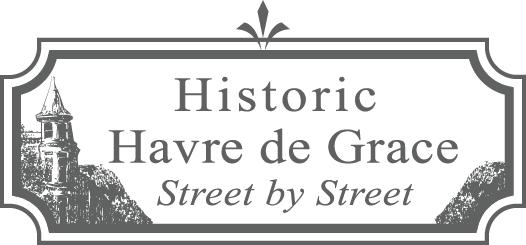Back to All Listings
800 Market Street, Currier House,
800 Market Street, Currier House,
c. 1790-1840
Stop #39 on The Lafayette Trail
In 1813, when the City of Havre de Grace lost nearly two-thirds of its buildings due to the burning of the town by the British, the Currier House was one of those left standing. The central portion of this Federal style cottage, consisting of the kitchen, dining room and three upstairs bedrooms, dates back to 1790. In 1830, a bakery was moved from the end of the block (where the Bayou Hotel was later built) and attached to the central portion of this house. This addition formed the two front porches, two upstairs bedrooms, and a bakery that operated here also on the ground floor. This house is now owned by Jane Currier, whose family first arrived in Maryland in 1648, and who grew up in this house.
The Curriers had owned and operated several farms in Cecil and Kent Counties. In 1861, Matthew Currier (1835-1865), a direct descendant of those first settlers and Jane Currier’s great-grandfather, lost all of the livestock, grains and produce from his Cecil County farm when federal troops appropriated everything to feed the fledgling Union Army. Unable to continue farming, Matthew freed his five slaves and moved his wife, Adeliza “Addie” Currier, and their five children to Havre de Grace where he operated a ferry across the Susquehanna River and purchased this home for his family. The present dining room has paneling planks that date to this period, discovered during renovation. The house remains structurally as it was, with low ceilings on the second floor and high ceilings on the first floor. A passageway, which runs from the basement to the attic, is evident between the front parlor and dining room walls and is thought to have been part of the Underground Railroad from 1861-1865.
Matthew Currier was shot dead in his ferry boat in 1865 leaving a widow and the five children. The family believes that Matthew was killed by bounty hunters while he was smuggling slaves across the Susquehanna River to freedom. William Currier, Matthew’s brother who lived at 820 Market Street, also was shot and Jane Currier believes it was because his nearby home may have been a “safe house.”
After Matthew was killed, his wife, Addie, by law was not allowed to earn a living so she had to relinquish her children to other families. She married Lewis D. Pusey in 1868 and had more children, including LaBerta Pusey (1869-1952). One of Addie’s sons, Oliver Reasin "O.R." Currier (1863-1936), was taken in by Matthew James Cameron (1826-1914), a local business owner. Following his high school graduation, O.R. joined Cameron in his family business, the Havre de Grace Livery Stable located at Franklin and Stokes Streets. O.R. later took over the livery and converted it into a garage as automobiles became more prominent during WWI.
This house was sold to the Morris Thomas family in 1882. They substantially enlarged the house, added the wrap-around porch and relocated the front entry to its present Market Street position. It remained in the Thomas family until 1937 when Oliver “Ollie” M. Currier (1896-1991), one of Matthew's grandsons, purchased it back from Morris and Mattie Baker Thomas. Over the years, Ollie continually renovated and modernized the structure with his wife, Grace Carroll J. Currier (1911-2000), parents of the current owner, Jane Currier.
As a boy, James “Jim” Alexander Currier (1886-1969), O.R.'s eldest son and Jane Currier’s Uncle, worked in his father’s livery stable on Franklin Street where they had 36 horses. He also hunted and guided until 1916 when a local businessman, Clarence C. Pusey, offered Jim a position in the post office. For the next 43 years Jim kept the government job and eventually retired as Postmaster. He and his wife, Grace, lived at 825 Market Street through their deaths.
During the years, Jim also worked as a guide for wealthy sport hunters (including the Duponts and other Bayou Hotel guests) in his own 40-foot gunning rig and a two-man sinkbox. In those days of the 1920s, bagging 250 canvasbacks at a time wasn’t unusual. At the same time he carved decoys in a workshop behind the house, and established himself as one of the Susquehanna Flats' prominent carvers. Jane Currier has said he carved his decoys out of old telephone poles dropped off behind this house.
In 1996, Jane Currier Belbot (who had married Paul Belbot) opened their bed and breakfast inn, after an intense two-year period of renovation and additions. Cedar shake shingles completely cover the exterior. When a “mystery” wall and door were uncovered in the dining room, the door was converted into a lighted cabinet displaying decoys carved by the late Jim Currier.
Jane Currier and her daughter, Sarah, now operate an historical bed and breakfast in the house. But she had no idea that the house, just up the street from the Concord Point Lighthouse, had also been a way station on the Underground Railroad. “My family certainly never talked about it,” she said. “My mother left three filing cabinets in the basement, chock-full of old documents and the history of the house, but there’s no mention in any of that about escaping slaves.”
County Records
Built 1930. 2968 sq ft, 6 baths, 2 stories, detached garage, 10,800 sq ft lot.
Built 1930. 2968 sq ft, 6 baths, 2 stories, detached garage, 10,800 sq ft lot.
